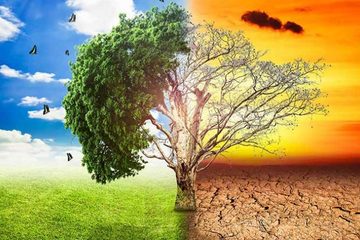We found 15 results that contain "green"
Posted on: #iteachmsu


Green World Concept
Green World is a literary concept defined by the critic Northrop Frye in his book, Anatomy of Criticism (1957). Frye defines this term using Shakespeare's romantic comedies as the foundation. ... The concept of the Green World is used to contrast the civilized world of man with the often harsh natural world.
Posted on: #iteachmsu


The causes, effects, and complexities of global warming are important to understand so that we can f
Global warming is the long-term warming of the planet’s overall temperature. Though this warming trend has been going on for a long time, its pace has significantly increased in the last hundred years due to the burning of fossil fuels. As the human population has increased, so has the volume of fossil fuels burned. Fossil fuels include coal, oil, and natural gas, and burning them causes what is known as the “greenhouse effect” in Earth’s atmosphere.
The greenhouse effect is when the sun’s rays penetrate the atmosphere, but when that heat is reflected off the surface cannot escape back into space. Gases produced by the burning of fossil fuels prevent the heat from leaving the atmosphere. These greenhouse gasses are carbon dioxide, chlorofluorocarbons, water vapor, methane, and nitrous oxide. The excess heat in the atmosphere has caused the average global temperature to rise overtime, otherwise known as global warming.
Global warming has presented another issue called climate change. Sometimes these phrases are used interchangeably, however, they are different. Climate change refers to changes in weather patterns and growing seasons around the world. It also refers to sea level rise caused by the expansion of warmer seas and melting ice sheets and glaciers. Global warming causes climate change, which poses a serious threat to life on Earth in the forms of widespread flooding and extreme weather. Scientists continue to study global warming and its impact on Earth.
The greenhouse effect is when the sun’s rays penetrate the atmosphere, but when that heat is reflected off the surface cannot escape back into space. Gases produced by the burning of fossil fuels prevent the heat from leaving the atmosphere. These greenhouse gasses are carbon dioxide, chlorofluorocarbons, water vapor, methane, and nitrous oxide. The excess heat in the atmosphere has caused the average global temperature to rise overtime, otherwise known as global warming.
Global warming has presented another issue called climate change. Sometimes these phrases are used interchangeably, however, they are different. Climate change refers to changes in weather patterns and growing seasons around the world. It also refers to sea level rise caused by the expansion of warmer seas and melting ice sheets and glaciers. Global warming causes climate change, which poses a serious threat to life on Earth in the forms of widespread flooding and extreme weather. Scientists continue to study global warming and its impact on Earth.
DISCIPLINARY CONTENT
Posted on: #iteachmsu


Global Warming (Globalization)
Global warming is a term used for the observed century-scale rise in the average temperature of the Earth's climate system and its related effects. Scientists are more than 95% certain that nearly all of global warming is caused by increasing concentrations of greenhouse gases (GHGs) and other human-caused emissions.
NAVIGATING CONTEXT
Posted on: #iteachmsu


Why dot balls are being shown as trees in scorecard in IPL 2023 playoffs
It is an initiative between TATA Group and Indian Premier League to encourage tree plantation drives around the country. TATA Group and IPL will plant 500 trees for every dot ball being bowled in the playoffs round in IPL 2023. This is part of BCCI’s green initiative. Playoffs will have 4 games, Qualifier 1, Eliminator 1, Qualifier 2, and The Final at Narendra Modi Cricket Stadium in Ahmedabad. Gujarat Titans, Chennai Super Kings, Lucknow Super Giants, and Mumbai Indians are the four teams taking part in the Indian Premier League’s playoffs round. Gujarat Titans and Chennai are fighting out on Tuesday evening to secure their place in the finals.
ASSESSING LEARNING
Posted on: Nutrition -- Edited...


By Shravya: What is nutrition and why is nutrition important? public child grp , public article
At the most basic level, nutrition is about eating a regular, balanced diet. Good nutrition helps fuel your body. The foods you eat supply the nutrients your body needs to maintain your brain, muscle, bone, nerves, skin, blood circulation, and immune system. Proper nutrition also helps protect you from illness and disease such as heart disease, diabetes, cancer, and osteoporosis.
There are two major classes of nutrients in food: macronutrients and micronutrients. Macronutrients are carbohydrates, protein, and fat. They supply energy (in the form of calories) and serve as the building blocks for muscles and tissues.
In comparison, micronutrients are individual vitamins and minerals. They are divided into four categories: water-soluble vitamins, fat-soluble vitamins, microminerals, and trace minerals.
While most foods in plant-based diets offer important health benefits, certain ones stand out. These "superfoods" pack the biggest nutritional punch. People should try to eat some of these healthy foods every day or as often as possible. They include the following:
Berries. High in fiber, berries are naturally sweet, and their rich colors mean they are high in antioxidants and disease-fighting nutrients.
Fatty fish. Fatty fish can be a good source of protein and omega-3 fatty acids, which help prevent heart disease. Those with the highest omega-3 content are salmon, mackerel, trout, anchovies, and sardines.
Leafy greens. Dark, leafy greens are a good source of vitamin A, vitamin C, and calcium, as well as several phytochemicals (chemicals made by plants) that fight inflammation and protect cells from damage.
Nuts. Hazelnuts, walnuts, almonds, and pecans are good plant protein sources. They also contain monounsaturated fats, which may be a factor in reducing the risk of heart disease.
Olive oil. Olive oil is a good source of vitamin E, polyphenols, and monounsaturated fatty acids, all of which help reduce the risk of heart disease.
Whole grains. A good source of soluble and insoluble fiber, whole grains also contain several B vitamins and minerals. They have been shown to lower cholesterol and protect against heart disease and diabetes.
Yogurt. A good source of calcium and protein, yogurt contains live cultures called probiotics. These "good bacteria" can protect the body from other harmful bacteria.
Cruciferous vegetables. These include broccoli, Brussels sprouts, cabbage, cauliflower, collard greens, kale, kohlrabi, mustard greens, radishes, and turnips. They are an excellent source of fiber, vitamins, and phytochemicals, which may help prevent some types of cancer.
Legumes. This broad category includes kidney, black, red, and garbanzo beans, soybeans, and peas. Legumes are an excellent source of fiber, folate, and protein; studies show they can help reduce the risk of heart disease.
There are two major classes of nutrients in food: macronutrients and micronutrients. Macronutrients are carbohydrates, protein, and fat. They supply energy (in the form of calories) and serve as the building blocks for muscles and tissues.
In comparison, micronutrients are individual vitamins and minerals. They are divided into four categories: water-soluble vitamins, fat-soluble vitamins, microminerals, and trace minerals.
While most foods in plant-based diets offer important health benefits, certain ones stand out. These "superfoods" pack the biggest nutritional punch. People should try to eat some of these healthy foods every day or as often as possible. They include the following:
Berries. High in fiber, berries are naturally sweet, and their rich colors mean they are high in antioxidants and disease-fighting nutrients.
Fatty fish. Fatty fish can be a good source of protein and omega-3 fatty acids, which help prevent heart disease. Those with the highest omega-3 content are salmon, mackerel, trout, anchovies, and sardines.
Leafy greens. Dark, leafy greens are a good source of vitamin A, vitamin C, and calcium, as well as several phytochemicals (chemicals made by plants) that fight inflammation and protect cells from damage.
Nuts. Hazelnuts, walnuts, almonds, and pecans are good plant protein sources. They also contain monounsaturated fats, which may be a factor in reducing the risk of heart disease.
Olive oil. Olive oil is a good source of vitamin E, polyphenols, and monounsaturated fatty acids, all of which help reduce the risk of heart disease.
Whole grains. A good source of soluble and insoluble fiber, whole grains also contain several B vitamins and minerals. They have been shown to lower cholesterol and protect against heart disease and diabetes.
Yogurt. A good source of calcium and protein, yogurt contains live cultures called probiotics. These "good bacteria" can protect the body from other harmful bacteria.
Cruciferous vegetables. These include broccoli, Brussels sprouts, cabbage, cauliflower, collard greens, kale, kohlrabi, mustard greens, radishes, and turnips. They are an excellent source of fiber, vitamins, and phytochemicals, which may help prevent some types of cancer.
Legumes. This broad category includes kidney, black, red, and garbanzo beans, soybeans, and peas. Legumes are an excellent source of fiber, folate, and protein; studies show they can help reduce the risk of heart disease.
Authored by: Vija
Justice and Belonging
Posted on: #iteachmsu


Which Foods You Should Eat To Increase Hemoglobin Count?
Hemoglobin is an iron-rich protein in red blood cells (RBCs). The normal hemoglobin range for men is 13.5 to 17.5 gm/dL and 12 to 15.5 gm/dL for women. It is of utmost importance to maintain hemoglobin concentration.
What you need to know:
What functions does hemoglobin perform in our bodies?
What causes low hemoglobin?
Symptoms of low hemoglobin
What are the foods that can increase hemoglobin level?
Tips to increase your hemoglobin levels
What functions does hemoglobin perform in our bodies?
Hemoglobin is vital for carrying oxygen from the lungs to tissues and organs. It also transports carbon dioxide from the tissues back to the lungs.
What causes low hemoglobin?
Some common causes of low hemoglobin are:
Substantial blood loss
Deficiency in iron, vitamin B, and folate
Kidney disease
Hypothyroidism
Thalassemia
Lung diseases
Excessive smoking
Any type of blood loss can cause anemia, including blood loss from surgery, heavy menstrual periods, and bleeding in the gastrointestinal tract.
Symptoms of low hemoglobin
You can detect extremely low hemoglobin levels in your system in a few ways. They include
A fast or irregular heartbeat
Fatigue
Frequent or unexplained bruising
Shortness of breath
Liver and kidney disease
Pale skin and gums
Muscle weakness
Reoccurring headaches
Dizziness
Poor appetite
Anemia in severe cases
Elevated hemoglobin levels are associated with dehydration, heart failure, and chronic lung disease. In some conditions, the bone marrow may not produce enough RBCs, leading to cancers like leukemia, lymphoma, or tumors that spread from other parts of the body into the bone marrow.
What are the foods that can improve your hemoglobin levels?
It is essential to boost your food intake to raise your hemoglobin levels. Here are some foods to increase hemoglobin levels:
Iron-rich foods: Consume iron-rich foods like fish, meat, eggs, soy products, broccoli, green leafy vegetables that include spinach, fenugreek leaves, cauliflower, green peas, cabbage, green beans, nuts and seeds, and peanut butter, to increase your hemoglobin levels.
Vitamin A: It is pertinent to consume vitamin A foods to increase hemoglobin as they absorb more iron. Vitamin A and beta-carotene can help you there. Vitamin A is found in animal food sources, such as fish and liver. Beta-carotene is found in red, yellow, and orange fruits and vegetables.
Folate: Folate is a type of Vitamin B that plays an essential part in hemoglobin production. A shortage of folate can prevent the red blood cells from maturing, leading to anemia. Some good sources of folate include beef, rice, black-eyed peas, kidney beans, lettuce, and peanuts.
Foods rich in vitamin C: A combination of iron and vitamin C can prove to be beneficial. The latter is used for better absorption of iron. Foods rich in vitamin C include oranges, lemon, strawberries, papaya, bell peppers, broccoli, and tomatoes.
Fruits: It is also perfect to have fruits like beetroot, apple, watermelon, papaya, oranges, litchis, kiwis, strawberries, grapefruit, banana, and peach, which can boost hemoglobin levels. Plus, dry fruits, like dates, can increase the number of erythrocytes, thereby increasing hemoglobin levels. They contain iron, vitamin C, vitamin B complex, and folic acid, which helps in the formation of red blood cells. Raisins are also a rich source of iron and copper necessary to form red blood cells.
Avoid iron blockers: Foods that block your body’s ability to absorb iron, such as coffee, tea, alcohol, and aerated drinks, should be avoided.
Tips to increase your hemoglobin levels
Here are some tips to keep in mind to increase your hemoglobin levels:
Switch to brown rice: As a superfood, brown rice can help prevent various diseases related to cholesterol and the gastrointestinal system. It is rich in iron, containing 0.52 milligrams of iron for every 100 grams.
Enjoy dark chocolate: With over 80% of cocoa, dark chocolate naturally improves hemoglobin levels. Plus, it is loaded with minerals, nutrients and antioxidants.
Drink nettle tea: The spice nettle has also proven to be a good source of iron and vitamin B and C. They can also play a part in increasing hemoglobin levels.
Exercise: Take up moderate to high-intensity exercise to help your body produce more hemoglobin to meet the oxygen demands of your body.
Stay tuned to the Activ Living Community. Keep up to date with the latest health tips and trends through expert videos, podcasts, articles, and much more in nutrition, fitness, mindfulness, and lifestyle conditions like Asthma, Blood Pressure, Cholesterol, and Diabetes.
You may also be interested in the following blogs:
10 Vegetarian Foods That Are Rich In Iron
Want to Add Iron Rich Foods to Add in Your Diet? Check Out These Iron Rich Foods.
What you need to know:
What functions does hemoglobin perform in our bodies?
What causes low hemoglobin?
Symptoms of low hemoglobin
What are the foods that can increase hemoglobin level?
Tips to increase your hemoglobin levels
What functions does hemoglobin perform in our bodies?
Hemoglobin is vital for carrying oxygen from the lungs to tissues and organs. It also transports carbon dioxide from the tissues back to the lungs.
What causes low hemoglobin?
Some common causes of low hemoglobin are:
Substantial blood loss
Deficiency in iron, vitamin B, and folate
Kidney disease
Hypothyroidism
Thalassemia
Lung diseases
Excessive smoking
Any type of blood loss can cause anemia, including blood loss from surgery, heavy menstrual periods, and bleeding in the gastrointestinal tract.
Symptoms of low hemoglobin
You can detect extremely low hemoglobin levels in your system in a few ways. They include
A fast or irregular heartbeat
Fatigue
Frequent or unexplained bruising
Shortness of breath
Liver and kidney disease
Pale skin and gums
Muscle weakness
Reoccurring headaches
Dizziness
Poor appetite
Anemia in severe cases
Elevated hemoglobin levels are associated with dehydration, heart failure, and chronic lung disease. In some conditions, the bone marrow may not produce enough RBCs, leading to cancers like leukemia, lymphoma, or tumors that spread from other parts of the body into the bone marrow.
What are the foods that can improve your hemoglobin levels?
It is essential to boost your food intake to raise your hemoglobin levels. Here are some foods to increase hemoglobin levels:
Iron-rich foods: Consume iron-rich foods like fish, meat, eggs, soy products, broccoli, green leafy vegetables that include spinach, fenugreek leaves, cauliflower, green peas, cabbage, green beans, nuts and seeds, and peanut butter, to increase your hemoglobin levels.
Vitamin A: It is pertinent to consume vitamin A foods to increase hemoglobin as they absorb more iron. Vitamin A and beta-carotene can help you there. Vitamin A is found in animal food sources, such as fish and liver. Beta-carotene is found in red, yellow, and orange fruits and vegetables.
Folate: Folate is a type of Vitamin B that plays an essential part in hemoglobin production. A shortage of folate can prevent the red blood cells from maturing, leading to anemia. Some good sources of folate include beef, rice, black-eyed peas, kidney beans, lettuce, and peanuts.
Foods rich in vitamin C: A combination of iron and vitamin C can prove to be beneficial. The latter is used for better absorption of iron. Foods rich in vitamin C include oranges, lemon, strawberries, papaya, bell peppers, broccoli, and tomatoes.
Fruits: It is also perfect to have fruits like beetroot, apple, watermelon, papaya, oranges, litchis, kiwis, strawberries, grapefruit, banana, and peach, which can boost hemoglobin levels. Plus, dry fruits, like dates, can increase the number of erythrocytes, thereby increasing hemoglobin levels. They contain iron, vitamin C, vitamin B complex, and folic acid, which helps in the formation of red blood cells. Raisins are also a rich source of iron and copper necessary to form red blood cells.
Avoid iron blockers: Foods that block your body’s ability to absorb iron, such as coffee, tea, alcohol, and aerated drinks, should be avoided.
Tips to increase your hemoglobin levels
Here are some tips to keep in mind to increase your hemoglobin levels:
Switch to brown rice: As a superfood, brown rice can help prevent various diseases related to cholesterol and the gastrointestinal system. It is rich in iron, containing 0.52 milligrams of iron for every 100 grams.
Enjoy dark chocolate: With over 80% of cocoa, dark chocolate naturally improves hemoglobin levels. Plus, it is loaded with minerals, nutrients and antioxidants.
Drink nettle tea: The spice nettle has also proven to be a good source of iron and vitamin B and C. They can also play a part in increasing hemoglobin levels.
Exercise: Take up moderate to high-intensity exercise to help your body produce more hemoglobin to meet the oxygen demands of your body.
Stay tuned to the Activ Living Community. Keep up to date with the latest health tips and trends through expert videos, podcasts, articles, and much more in nutrition, fitness, mindfulness, and lifestyle conditions like Asthma, Blood Pressure, Cholesterol, and Diabetes.
You may also be interested in the following blogs:
10 Vegetarian Foods That Are Rich In Iron
Want to Add Iron Rich Foods to Add in Your Diet? Check Out These Iron Rich Foods.
Authored by: Vijaya
Assessing Learning
Posted on: #iteachmsu


Global Warming
Earth has warmed and cooled time and again. Climate has changed when the planet received more or less sunlight due to subtle shifts in its orbit, as the atmosphere or surface changed, or when the Sun’s energy varied. But in the past century, another force has started to influence Earth’s climate: humanity
How does this warming compare to previous changes in Earth’s climate? How can we be certain that human-released greenhouse gases are causing warming? How much more will the Earth warm? How will Earth respond? Answering these questions is perhaps the most significant scientific challenge of our time.
What is Global Warming?
Global warming is the unusually rapid increase in Earth’s average surface temperature over the past century primarily due to the greenhouse gases released as people burn fossil fuels. The global average surface temperature rose 0.6 to 0.9 degrees Celsius (1.1 to 1.6° F) between 1906 and 2005, and the rate of temperature increase has nearly doubled in the last 50 years.
How does this warming compare to previous changes in Earth’s climate? How can we be certain that human-released greenhouse gases are causing warming? How much more will the Earth warm? How will Earth respond? Answering these questions is perhaps the most significant scientific challenge of our time.
What is Global Warming?
Global warming is the unusually rapid increase in Earth’s average surface temperature over the past century primarily due to the greenhouse gases released as people burn fossil fuels. The global average surface temperature rose 0.6 to 0.9 degrees Celsius (1.1 to 1.6° F) between 1906 and 2005, and the rate of temperature increase has nearly doubled in the last 50 years.
Authored by: Rupali
Assessing Learning
Posted on: #iteachmsu


Global warming
Global warming is the long-term heating of Earth's climate system observed since the pre-industrial period (between 1850 and 1900) due to human activities, primarily fossil fuel burning, which increases heat-trapping greenhouse gas levels in Earth's atmosphere.
Authored by: admin
Posted on: #iteachmsu


Before spectroscopic analysis (IR, NMR) became commonplace in the organic chemistry lab
Before spectroscopic analysis (IR, NMR) became commonplace in the organic chemistry lab, chemical tests were heavily relied upon to support compound identification. A chemical test is typically a fast reaction performed in a test tube that gives a dramatic visual clue (a color change, precipitate, or gas formation) as evidence for a chemical reaction. For example, addition of an orange chromic acid reagent to some compounds causes the chromium reagent to change to a blue-green color (Figure 6.37a). This is considered a "positive" test result, and in this case indicates the presence of a functional group that can be oxidized (alcohol or aldehyde). A negative test result is retention of the original color of the reagent, in this case the orange color
https://chem.libretexts.org/Bookshelves/Organic_Chemistry/Book%3A_Organic_Chemistry_Lab_Techniques_(Nichols)/06%3A_Miscellaneous_Techniques/6.04%3A_Chemical_Tests/6.4A%3A_Overview_of_Chemical_Tests
https://chem.libretexts.org/Bookshelves/Organic_Chemistry/Book%3A_Organic_Chemistry_Lab_Techniques_(Nichols)/06%3A_Miscellaneous_Techniques/6.04%3A_Chemical_Tests/6.4A%3A_Overview_of_Chemical_Tests
Posted by: Chathuri Super admin..
Navigating Context
Posted on: #iteachmsu

Formative Assessments
Researcher Laura Greenstein sums up a professional consensus on formative assessment, which is rooted in three significant concepts:
Formative assessment is focused on students.
Formative assessment is instructionally informative.
Formative assessment is based on outcomes. Frequent opportunities for teachers to identify student progress and provide feedback are at the heart of formative assessment. Formative assessments are used to capture snapshots of students' knowledge or skill at particular moments. There are many ways that teachers generate these snapshots of how their students are doing to track their progress.
Some aspects of effective formative assessment strategies include:
Use questions as assessments and as feedback that moves learning forward.
Involve students in thinking about their learning.
Plan to assess learning during and between lessons (short-cycle formative assessment).
Provide immediate feedback.
Look for patterns in student work and plan future instruction based on the results.
Formative assessment is focused on students.
Formative assessment is instructionally informative.
Formative assessment is based on outcomes. Frequent opportunities for teachers to identify student progress and provide feedback are at the heart of formative assessment. Formative assessments are used to capture snapshots of students' knowledge or skill at particular moments. There are many ways that teachers generate these snapshots of how their students are doing to track their progress.
Some aspects of effective formative assessment strategies include:
Use questions as assessments and as feedback that moves learning forward.
Involve students in thinking about their learning.
Plan to assess learning during and between lessons (short-cycle formative assessment).
Provide immediate feedback.
Look for patterns in student work and plan future instruction based on the results.
Posted by: Roni Smith
Posted on: #iteachmsu


Measuring Global Ocean Heat Content to Estimate the Earth Energy Imbalance
Estimating and analyzing the Earth Energy Imbalance (EEI) is essential for understanding the evolution of the Earth’s climate. This is possible only through a careful computation and monitoring of the climate-energy budget. The climate system exchanges energy with outer space at the top of the atmosphere (TOA) (through radiation) and with solid Earth at the Earth’s crust surface (essentially through geothermal flux). If the climate system were free from external perturbations and internal variability during millennia, then the climate-energy budget would be in a steady state in which the net TOA radiation budget compensates the geothermal flux of +0.08 Wm–2 (Davies and Davies, 2010).
But the climate system is not free from external perturbations and from internal variability. Although the geothermal flux does not generate any perturbations at interannual to millennial time scales (because it varies only at geological time scales), other external forcings from natural origin (such as the solar radiation, the volcanic activity) or anthropogenic origin (such as Greenhouse Gas emissions –GHG-) perturb the system.
REf:https://www.frontiersin.org/articles/10.3389/fmars.2019.00432/full
But the climate system is not free from external perturbations and from internal variability. Although the geothermal flux does not generate any perturbations at interannual to millennial time scales (because it varies only at geological time scales), other external forcings from natural origin (such as the solar radiation, the volcanic activity) or anthropogenic origin (such as Greenhouse Gas emissions –GHG-) perturb the system.
REf:https://www.frontiersin.org/articles/10.3389/fmars.2019.00432/full
Posted by: Chathuri Hewapathirana
Disciplinary Content
Posted on: #iteachmsu

A super-intelligent AI will be extremely good at accomplishing its goals, and if those goals aren’t aligned with ours, we have a problem.
You’re probably not an evil ant-hater who steps on ants out of malice, but if you’re in charge of a hydroelectric green energy project and there’s an anthill in the region to be flooded, too bad for the ants.
A key goal of AI safety research is to never place humanity in the position of those ants.
You’re probably not an evil ant-hater who steps on ants out of malice, but if you’re in charge of a hydroelectric green energy project and there’s an anthill in the region to be flooded, too bad for the ants.
A key goal of AI safety research is to never place humanity in the position of those ants.
Posted by: Rupali Jagtap
Host: MSU Libraries

Latine Voces Uncensored: Symposium on Latine Narratives
The digital age has brought us virtually (pun, intended) limitless access to information in the digital age. Despite this access, Latine communities continue to confront the challenges of rampant misinformation, censorship and misrepresentation—influencing how Latines are depicted in news coverage to popular culture to domestic and international policies that directly impact (and harm) our communities. Accurate Latine narratives and exposure to our histories are as important as ever. In this timely and important symposium, we address representation and free speech through the lens of Puerto Rican storytelling.
Hosted by Latino Spartans & MSU Chicanx/Latinx Association (ChiLA).
Note: The first half of this event will take place at the Multicultural Center. The Library portion will begin at 1:30 in the Green Room.
Please register by clicking here
Navigating Context
Host: MSU Libraries

Midday Moves
Join your Move More @ Work Team for a full body strength and stretch routine. Exercises are body weight, low-impact, and can be done seated or standing.
Move More @ Work is an ongoing campaign facilitated by University Health and Wellbeing’s Health Promotion and Engagement office. Their goal is to encourage Spartans to engage in physical activity and movement throughout the workday.
This series is a free group fitness class (in person and virtual) to take a movement break during the workday. Two ways to join: in-person in the Green Room at the MSU Library or via Zoom.
Register here. If you do not register online, you will be asked to upon arrival. Zoom link provided upon registration.
Navigating Context
EXPIRED



